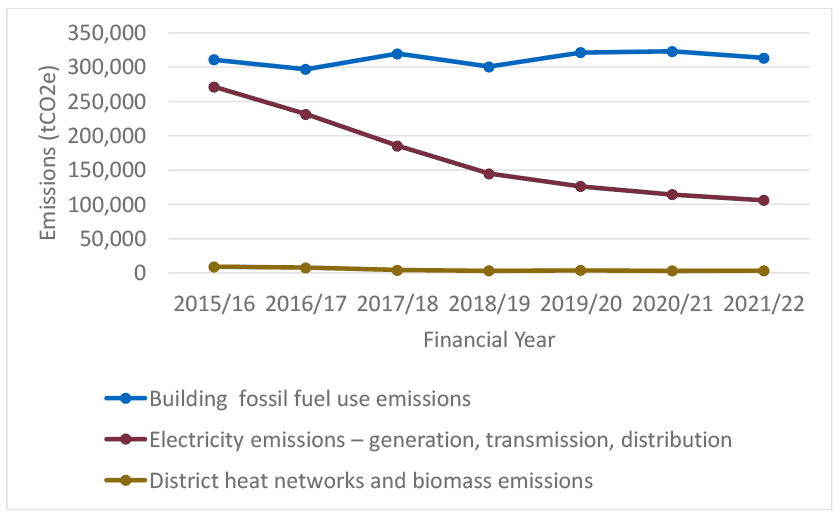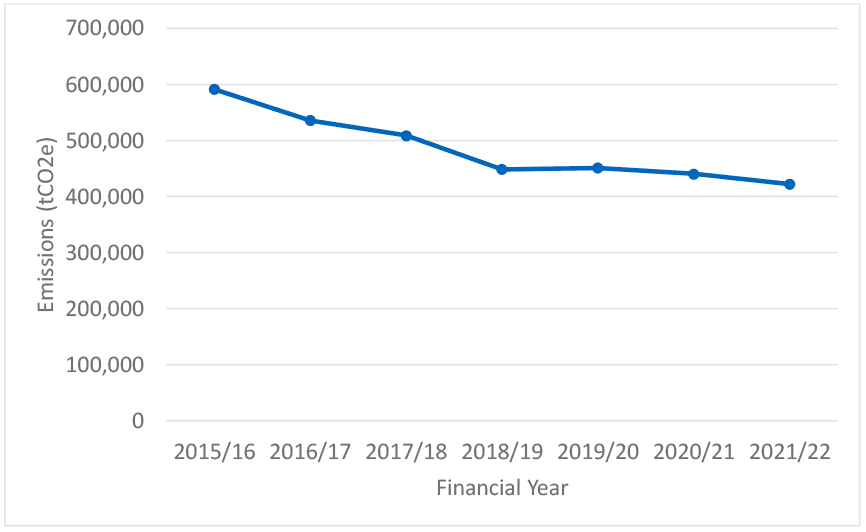NHS Scotland - climate emergency and sustainability: annual report 2021 to 2022
Report for 2021 to 2022 providing information on; greenhouse gas emissions arising from the operations of NHS Scotland, actions which have been taken or are underway to reduce NHS Scotland’s greenhouse gas emissions and environmental impact, and actions to adapt to climate change.
3. Building Energy
The NHS uses electricity to power its buildings, equipment and (increasingly) its vehicles. It also needs to heat its buildings. Greenhouse gases are emitted through the burning of fossil fuels for heat at NHS sites and also in the generation of electricity supplied through the national grid.
Reducing emissions in building energy use is part of the NHS’s 2040 net-zero target. The NHS also has a target of using renewable heat for all the buildings it owns by 2038.
Figure 2 below shows how NHS Scotland’s emissions from building fossil fuel use, district heat networks and biomass, and electricity have changed over the last seven years. Figure 3 shows the overall trend of emissions. These figures include emissions released from burning the fuels and by the processes of extracting and suppling the fuels to the NHS (“well to tank emissions”). A table of these figures is included in the Annex.
Figure 2:

Source: NHS National Services Scotland - National Energy Management System
Figure 3:

Source: NHS National Services Scotland - National Energy Management System
3.1 Building fossil fuel emissions
Building fossil fuel emissions have not decreased over the last seven years – they were 311,000 tCO2e in 2015/16 and 313,000 tCO2e in 2021/22. This can be attributed to a focus on decreasing electricity consumption but it underlines that a change in approach is needed. A consistent decrease in building fossil fuel emissions is needed to meet the 2038 renewable heat target and the overall 2040 net-zero target.
3.2 District heat networks and biomass
There has been a decrease in emissions from district heat networks and biomass. In general, zero emissions heat networks are likely to be a preferred heating option for a number of NHS sites. Health facilities can provide a baseload of heat demand, increasing the economic viability of heat networks and contributing to heat decarbonisation beyond the boundaries of the NHS. However, at this stage the decrease in emissions from district heat networks and biomass emissions can be considered neutral – no positive or negative conclusions can be drawn from it.
3.3 Electricity
Emissions from NHS Scotland’s use of electricity decreased by 61% between 2015/16 and 2021/22 because the electricity supplied through the national grid in the UK has become a lot less carbon intensive over the last seven years and the NHS has reduced its electricity usage.
Over the last seven years, the use of coal to generate electricity has significantly reduced. 360 g of CO2 equivalent was produced for every kWh of electricity in 2015. That fell to 149 g of CO2 equivalent for every kWh in 2021. The amount of CO2 equivalent produced in generating electricity is forecast to fall even further (to 18 g per kWh in 2038 and 2 g per kWh by 2050[i]) as electricity is increasingly produced by renewable power.
The NHS has also reduced its electricity consumption over the last seven years from 546,159 MWh in 2015/16 to 457,877 MWh in 2021/22, a decrease of 16%. Reducing electricity consumption is essential not only for reducing emissions in the short-term, but also to allow for more electricity to be used for electric vehicles and for producing heat.
Information on building energy emissions at Health Board level is set out in the Annex to this report.
3.4 Actions taken
As of February 2023, the Scottish Government’s Central Government Energy Efficiency Grant Scheme is supporting six Health Boards with capital funding of £11.8 million to deliver projects and six Health Boards with £285,000 of revenue funding to prepare a programme of decarbonisation and energy efficiency projects. Funding had been awarded to ten Health Boards in total. This scheme is an open fund meaning that Health Boards can continue to submit applications to it for funding. The following Health Boards had funding agreed as of February 2023
| Organisation | Funding type | Project value | Completion year |
|---|---|---|---|
| 1. Ayrshire and Arran | Capital | £873,000 | 22/23 |
| Pre-capital | £47,000 | 22/23 | |
| 2. Borders | Pre-capital | £50,000 | 22/23 |
| 3. Fife | Pre-capital | £48,000 | 22/23 |
| 4. Forth Valley | Capital | £1,962,000 | 23/24 |
| 5. Grampian | Pre-capital | £50,000 | 22/23 |
| 6. Greater Glasgow and Clyde | Capital | £1,312,000 | 23/24 |
| Capital | £498,000 | 22/23 | |
| Capital | £432,000 | 22/23 | |
| 7. Lanarkshire | Pre-capital | £50,000 | 22/23 |
| 8. Lothian | Capital | £2,000,000 | 22/23 |
| 9. Orkney | Capital | £3,987,000 | 24/25 |
| 10. Tayside | Capital | £761,000.00 | 23/24 |
| Pre-capital | £40,000 | 22/23 | |
| Total | Pre-capital | £285,000 | 22/23 |
| Capital | £11,800,000 | 22/23 |
Contact
Email: DHFCGVAdminSupport@gov.scot
There is a problem
Thanks for your feedback